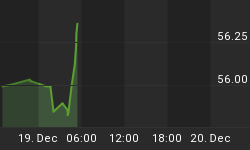While some traders were distracted by the G-8 meeting and the possibility the BRIC nations will propose a plan to make central banks less dependent on the U.S. Dollar as the world's reserve currency, other traders focused on why they should be long the Dollar at this time. These traders live in the now and are not distracted by future plans.
The main short-term factor that is controlling the market at this time is that investors are afraid of losing money. They are once again feeling the need to bring the money back home to avoid the risk of losing it again in the equity market or some other higher yielding asset.
Investors are once again showing that they are willing to take almost nothing in the short-term Treasury markets in exchange for return of their capital rather than return on their capital.
As long as equity markets remain under pressure, look for traders to be averse to risk. This should help support the Dollar against most Forex majors. Investors do not seem to care about the Treasury issuing more debt, about inflation or about the Dollar losing its status as the world's reserve currency.
What traders want today is safety and security. No matter how much the Dollar gets bashed in the press by the People's Bank of China and the Russian government. Global investors are showing that during times of economic uncertainty, they know they always have the Dollar to which to turn.
The GBP USD continued to lose ground on the thought that the Bank of England may announce that it is increasing the amount of funds available for quantitative easing. This is in effect an announcement that the BoE is willing to flood the market with British Pounds. If the BoE announces the new plan then it is telling traders two things: one, the U.K. economy is worse than previous estimated, and, two, quantitative easing is bearish for a currency and it may lead to inflation.
The weaker equity markets and thoughts of the U.S. economy starting another lower slide are helping the Japanese Yen appreciate. Trader demand for higher risk assets is diminishing. Japanese investors who moved money out of the Yen for higher yields are now buying Yen for protection against a loss. Look for the USD JPY to feel downside pressure as long as money is being lost in the equity markets.
The USD CHF traded slightly better in tight trading on Wednesday. This should come as no surprise because this market has been in a tight range for several weeks.
Three factors seem to be responsible for the holding pattern developing in this market.
Firstly, there is no interest rate differential with which to work. Both the U.S. Federal Reserve and the Swiss National Bank have held interest rates at close to zero for several months. This means that neither country is more attractive than the other when it comes to interest rates. Although expectations are for U.S. rates to be higher one year from now, this line of thought is not being reflected in the market at this time.
Secondly, the sensitivity of the Swiss Franc to the price of gold has put downside pressure on the market. There is no question that at times the Swiss Franc moves lock-step with gold. The Swiss Franc has felt modest pressure since the gold market topped in early June. Since then the trend in both markets has been sideways-to-lower. Look for this pattern to continue unless gold makes a sharp move downward. If this occurs then the Swiss Franc should break support and accelerate to the downside.
Finally, speculators seem to be challenging the Swiss National Bank's efforts to weaken its currency through intervention. Since March the SNB has made no secret that it wants to see a weaker currency against the Euro. This has led to two significant interventions in which the SNB aggressively bought the Euro and the U.S. Dollar while simultaneously selling Swiss Francs. Both interventions had dramatic one day effects on the Swiss Franc but each time speculators stepped in to stop the decline.
The latest action by the Swiss National Bank on June 24 triggered a massive break in the Swiss Franc but speculators went on a buying spree the very next day which helped start a rally that took back more than 50% of the intervention break.
The battle between speculators and the Swiss central bank has created a range bound market that is trading both sides of a 50% level 1.0805. The sideways action and the relative ease that speculators have moved the currency in the wake of the interventions have raised questions about the effectiveness of the SNB's strategy.
History has shown that despite having access to seemingly unlimited amounts of funds, central banks can lose the intervention battle. This may be inflationary over the long-term if the situation is not monitored or kept in check. With a solid bottom established at 1.0590 and the intervention top set at 1.1020, do not be surprised if this market stays in a range for a couple more months. Based on an intervention in March and June, the Swiss National Bank may not try to intervene again until September. This pattern may change depending on how aggressive the SNB wants to get. Traders should also note that the SNB may decide to sell gold in an effort to weaken its currency.
















